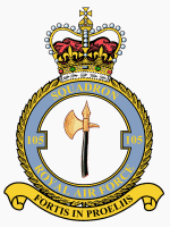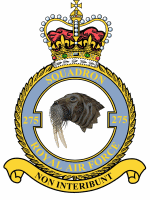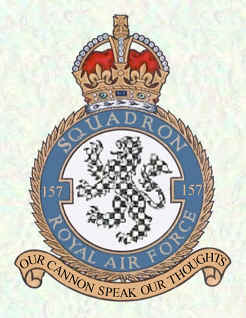
No. 683 Squadron RAF was a photo-reconnaissance squadron of the Royal Air Force during the Second World War and from August 1950 to November 1953.
No. 628 Squadron RAF was a meteorological and air-sea rescue squadron of the Royal Air Force during the Second World War.
No. 119 Squadron RAF was a squadron of the Royal Air Force, flying with RAF Coastal Command during the Second World War. It was the only RAF unit flying the Short G class and Short C class flying boats.

No. 354 Squadron RAF was a general reconnaissance squadron of the Royal Air Force during the Second World War.
No. 282 Squadron was a Royal Air Force air-sea rescue squadron during the Second World War.
No. 281 Squadron was a Royal Air Force air-sea rescue squadron during the Second World War.
No. 280 Squadron was a Royal Air Force air-sea rescue squadron during the Second World War.
No. 283 Squadron was a Royal Air Force squadron that served during the Second World War in the air-sea rescue (ASR) mission role while flying Supermarine Walruses and both in ASR and the anti-submarine patrol role while flying Vickers Warwicks.
No. 681 Squadron RAF was a photo-reconnaissance squadron of the Royal Air Force during the Second World War.
No. 261 Squadron RAF was a squadron of the Royal Air Force during World War I and World War II. It was involved in the defence of Malta from August 1940 till May 1941 and the campaign in Burma.
No. 228 Squadron RAF was a squadron of the Royal Air Force active at various times between 1918 and 1964. It spent the greatest part of its existence flying over water, doing so in the First, and Second World Wars and beyond, performing anti-submarine, reconnaissance and air-sea rescue tasks.

No. 105 Squadron was a flying squadron of the Royal Air Force, active for three periods between 1917 and 1969. It was originally established during the First World War as a squadron of the Royal Flying Corps and disbanded after the war. Reactivated shortly before the Second World War, it was inactive again after the conflict. During its second existence it was a bomber unit and had the distinction to be the first to operate the de Havilland Mosquito light bomber. During the 1960s it was reactivated again for six years to provide transport support for the British Army in the Aden Protectorate and the Far East.
No 297 Squadron was a squadron of the Royal Air Force. It was notable for being the first airborne forces squadron formed. With sister No 296 Squadron it formed No 38 Wing RAF in January 1942, joined in August by No 295 Squadron; the Wing expanded in 1943 to become No 38 Group RAF. The squadron saw action in Sicily and took part in the D-Day invasion and Operation Market Garden. It was disbanded in 1950.
No. 293 Squadron was a Royal Air Force air-sea rescue squadron. During the Second World War the unit operated search and rescue missions for Allied aircraft operating over Italy.
No. 294 Squadron was a Royal Air Force air search and rescue (ASR) squadron active under RAF Middle East Command. During the Second World War the unit operated rescue missions for Allied aircraft and aircrew over the eastern Mediterranean and later the Persian Gulf and Arabian sea.

No. 275 Squadron RAF was a Royal Air Force air-sea rescue squadron that served between 1941 and 1959.
No. 624 Squadron RAF was at first a special duties squadron of the Royal Air Force during World War II. It was later in the war tasked with mine-spotting, until disbanded at the end of the war.
No. 292 Squadron RAF was an air-sea rescue (ASR) squadron of the Royal Air Force operating in the Bay of Bengal during the Second World War.

No 279 Squadron RAF was a Royal Air Force air-sea rescue squadron of World War II. The squadron was formed on 16 November 1941 and disbanded on 10 March 1946.

No. 157 Squadron RAF was a Royal Air Force Squadron active as a night fighter unit in the Second World War.





